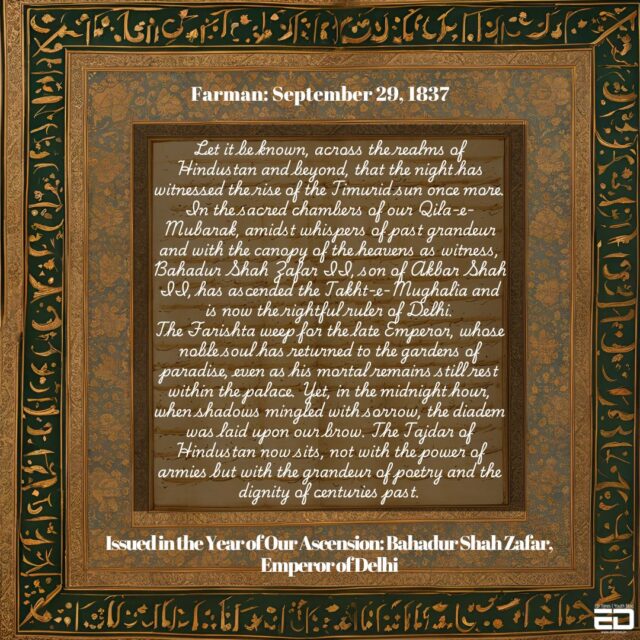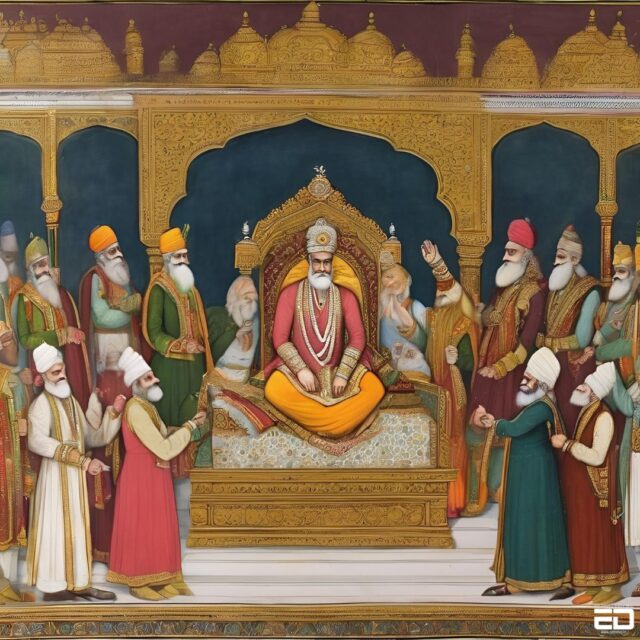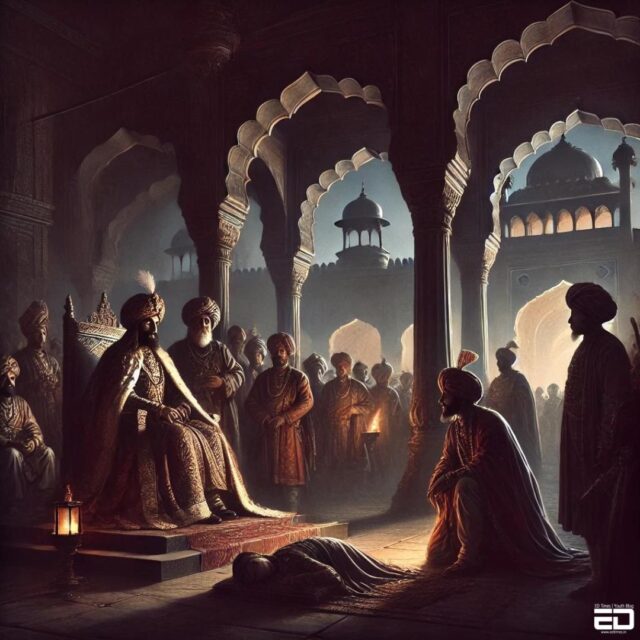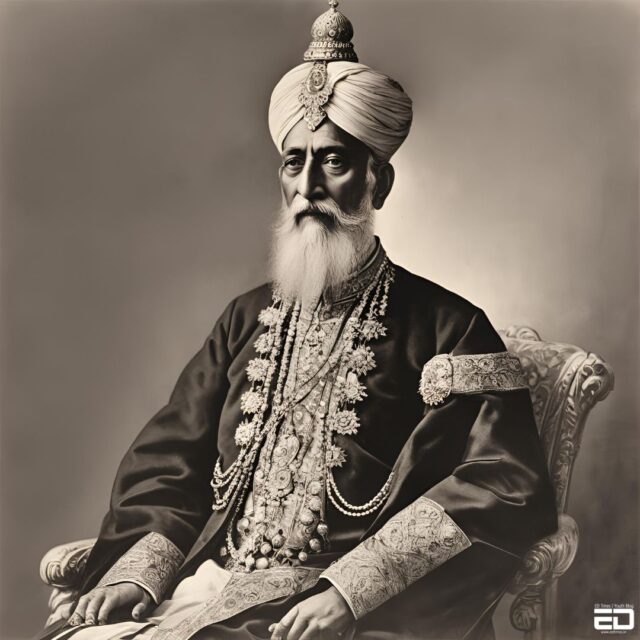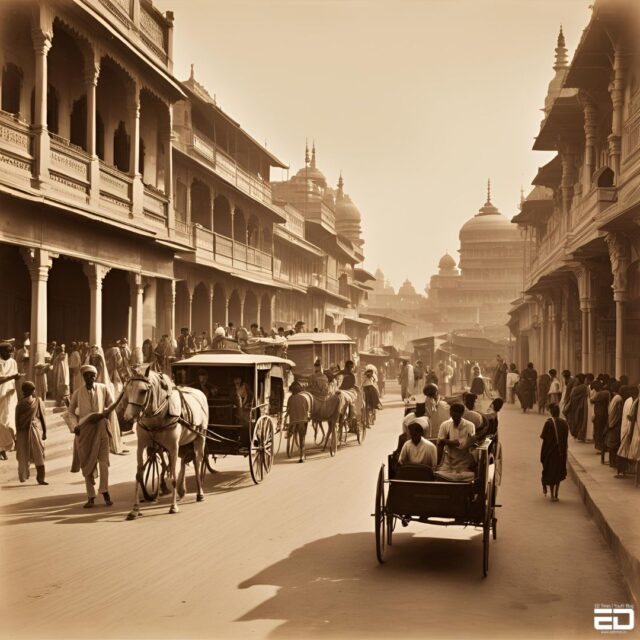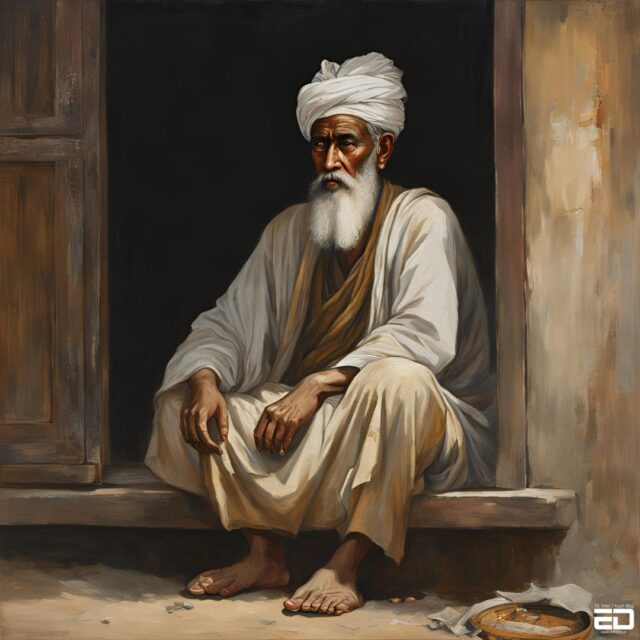Back in Time is ED’s newspaper-like column that reports an incident from the past as though it happened just yesterday. It allows the reader to re-live it several years later, on the date it occurred.
Delhi, September 29, 1837: A momentous night unfolded within the high walls of the Red Fort as Abu Zafar Siraj ud-Din Muhammad ascended the Mughal throne in a hushed yet symbolic coronation. In the dead of night, while the city slept, the son of Akbar Shah II was crowned the new Emperor of Delhi, as Bahadur Shah Zafar.
The coronation was an intimate affair, wrapped in the melancholy of the occasion. The body of the late Emperor, Akbar Shah II, still lay unburied within the palace, a reminder of the transitory nature of power. Yet, with all the decorum of his royal heritage, Bahadur Shah Zafar accepted the crown, now bearing more history than authority. Ironically, the emperor ascended with the name Zafar, which means victory.
Though the British have long held the reins of real power, controlling everything from taxes to the corridors of influence, they have allowed the Mughal dynasty to remain a nominal figurehead. Though attended by royal courtiers, poets, and family members, this coronation carried little weight beyond the Red Fort’s gates.
A Poetic King, Not A Politician
Bahadur Shah Zafar is no warrior, nor does he pretend to be one. Known more for his poetry than statecraft, the new Emperor is expected to spend more time in his writing chambers than in council rooms. In a city once ruled by emperors with armies, it is now led by an emperor with a pen.
It came as no surprise that his words last night were tinged with both resignation and resilience. “What remains of our empire is little more than walls,” he admitted, “but these walls have witnessed more than the world can imagine.”
Read More: Back In Time: 98 Years Ago Today, Indian Revolutionaries Launched “Kakori Train Action” Against British Atrocities
A City In Transition
The people of Delhi, many of whom remained unaware that the city had a new emperor until sunrise, appeared unmoved by the ceremony. Life continued as usual in the bustling bazaars and narrow lanes, while the British residents went about their business, seemingly indifferent to the shifting of titles within the fort.
The British East India Company, whose influence now extends far beyond the Mughal palace, continues to collect revenues and dictate terms, with Resident Charles Metcalfe acting as the real power behind the scenes. The Company’s officials were present at the coronation but offered little in the way of public comment as if to underline the symbolic nature of Zafar’s rule.
A Final Curtain For The Mughals?
For many, last night’s coronation felt less like the beginning of a new reign and more like the closing chapter of a once-glorious empire. The Mughals, who once ruled over vast territories with unparalleled wealth and power, now reign only over memories. Bahadur Shah Zafar, at 62, is unlikely to alter this trajectory. His reign, it seems, will be one of quiet dignity rather than sweeping change.
The most poignant symbol of the night was the empty audience chamber, where once, princes and nobles from across the subcontinent would have gathered to pay homage to the new Emperor. Instead, the walls stood witness to an intimate gathering, more a family affair than a grand ceremony.
Post Scriptum
A reluctant figurehead, Bahadur Shah Zafar found himself at the centre of the 1857 War of Independence, also known as the Indian Mutiny when Indian soldiers sought a symbol to unite their cause against British domination.
Despite his advanced age and lack of real political or military power, Zafar was chosen as the nominal leader of the rebellion, which briefly recaptured Delhi. However, the movement was eventually crushed by the better-equipped British forces.
After the fall of Delhi, Bahadur Shah Zafar’s life took a tragic turn. He was captured at Humayun’s Tomb, where he had sought refuge. The execution of his sons and grandson by Major William Hodson near the Khooni Darwaza in Delhi marked a brutal end to his lineage.
Following a sham trial, Zafar was exiled to Rangoon (now Yangon) in Burma, where he died in 1862, a defeated king who witnessed the dissolution of his empire and the death of his dynasty.
Beyond his political role, Zafar was a revered poet and Sufi mystic. His poetry, filled with themes of sorrow, loss, and despair, reflected the tumultuous times he lived in and the personal tragedies he endured. Zafar’s verse captured the existential helplessness of a king deprived of power and homeland.
His name continues to evoke reverence in India, Pakistan, and Bangladesh, where roads, parks, and institutions are named in his honour, and his poetry continues to resonate with those reflecting on themes of loss, defeat, and resilience.
“Na kisi ki aankh ka noor hoon, na kisi ke dil ka qaraar hoon;
Jo kisi ke kaam na aa sake, main wo ek musht-e-ghubaar hoon.”
(I am neither the light of anyone’s eyes nor the comfort of anyone’s heart;
I am nothing but a fistful of dust, of no use to anyone.)
Image Credits: Google Images
Sources: Indianculture.gov.in, Asia Society, Deccan Herald
Find the blogger: Katyayani Joshi
This post is tagged under: Indian History, Mughal Empire, Historical Events, Cultural Heritage, Heritage Of India, Timeless Tales, History Matters, Indian Culture, Legacy Of The Mughals, Bahadur Shah Zafar, Mughal Dynasty, The Last Mughal, Delhi History, Zafar The Poet King, Mughal Glory, Red Fort Chronicles, Mughal Heritage, Colonial India, Indian Mutiny 1857, War Of Independence 1857, Freedom Struggle, British Raj
Disclaimer: We do not hold any right, or copyright over any of the images used, these have been taken from Google. In case of credits or removal, the owner may kindly mail us.
Other Recommendations:
Back In Time: India’s First Train Gets Flagged Off From Bombay

























